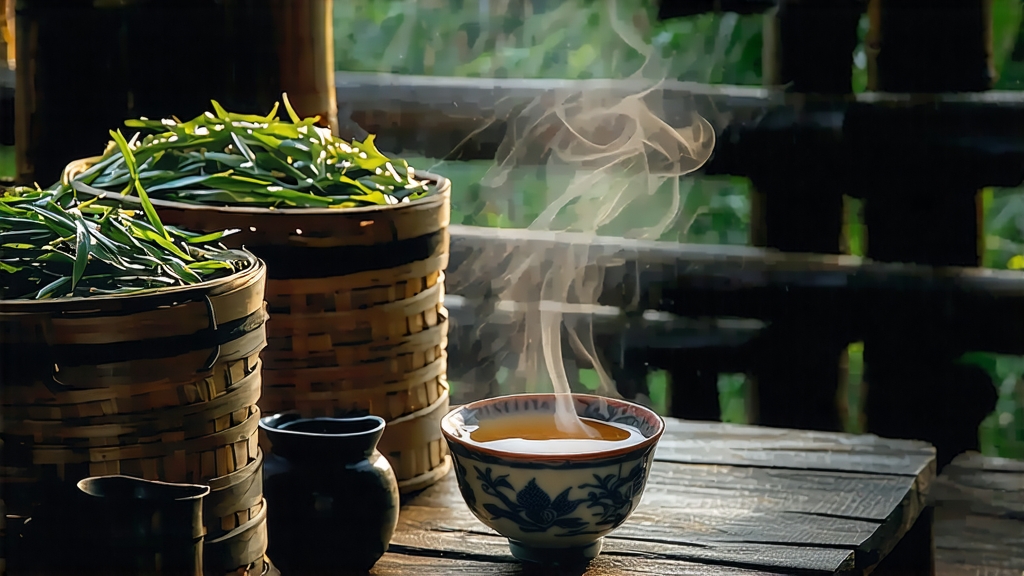
Tucked away in the humid, karst-pocked southwest of China, the small city of Wuzhou, Guangxi, has kept a secret for more than 1 500 years. While Pu-erh has become the global shorthand for dark, post-fermented tea, its quieter cousin—Liu Bao—has remained the beverage of dockworkers, herbalists, and grandmothers who believe good digestion is the first step to longevity. Named after the six (“Liu”) ancient forts (“Bao”) that once guarded the trade routes to Guangdong, Liu Bao is a living archive of Ming-dynasty techniques, Qing-era commerce, and 21st-century microbiology. To drink it is to taste the camphor forests of Guangxi, the camphor warehouses of Hong Kong, and the slow oxidation that only subtropical humidity can choreograph.
History: From Border Garrison to Maritime Silk Road
Liu Bao’s earliest written record appears in the 1541 edition of the Guangxi Provincial Gazetteer, where it is listed as “Wu Zhou Cang Cha”—warehouse tea—because soldiers stored it in earthen jars to ward off malaria. By the late 17th century the tea had migrated down the Xun River to the Pearl River Delta, where British and Cantonese merchants loaded it onto junks bound for Singapore and Kuala Lumpur. In 1802 the schooner Diana logged “Lew Pow tea” as ballast; the compressed leaves absorbed bilge water without molding, convincing captains that the darker the leaf, the safer the cargo. When the British East India Company lost its monopoly in 1834, Liu Bao slipped quietly into diasporic Chinatowns, becoming the secret ingredient in “kopi-cha”—coffee-tea—served by Hainanese cooks on rubber plantations. Thus a frontier medicine morphed into a maritime commodity, and finally into a nostalgic flavor that Malaysian grandfathers still describe as “smell of grandfather’s shop.”
Micro-terroirs within Sixteen Villages
Guangxi’s subtropical monsoon climate delivers 1 600 mm of rain annually, but Liu Bao’s character is decided by micro-valleys. The four most sought-after villages—Tongping, Yilong, Xianyi, and Shanzui—sit on red sandy loam derived from Devonian limestone. Here, wild Camellia sinensis var. sinensis bushes grow shoulder-high, their roots drilling into mineral seams that give a natural betel-nut bite. Above 500 m the variety “Lao Qing Cha” (old green tea) keeps its leaves oval and thick; below 300 m the cultivar “Ruan Zhi” (soft branch) yields more polyphenols but less caffeine, ideal for overnight laborers who need hydration without jitters. After 1949 the state designated Wuzhou as the sole “Liu Bao Production Region,” yet connoisseurs still speak of “pre-57” teas—leaves picked before the collectivization that replaced stone-fermentation vats with concrete floors.
Crafting the Tea: A Dialogue Between Steam and Microbes
Liu Bao’s processing follows a 24-step cycle that begins on the first misty morning after Qingming. Pickers take only the third and fourth leaves—mature, leathery, and already edged with insect bites—believing that wounded leaves invite richer microbial communities. After a brief outdoor wilting the leaves are loaded into a wok heated to 280 °C for exactly 240 seconds; this “sha qing” (kill-green) step deactivates browning enzymes but preserves spores of Eurotium cristatum, the golden mold that will later paint the leaf surface with microscopic constellations. While still steaming, the leaves are piled into bamboo baskets and rolled underfoot in a slow dance that ruptures 60 % of cell walls without shredding the surface. The crucial divergence from Pu-erh occurs next: the baskets are lowered into a brick-lined steam chamber where 95 % humidity and 55 °C trigger “wo dui”—moist piling—for 10–14 hours. Masters gauge readiness by smell: when the aroma shifts from grassy to dried longan, the pile is broken up and sun-dried on rattan trays. The semi-fermented maocha is then packed into 50 kg rattan baskets lined with camphor leaves and stored in caves along the Xun River. For three